A Multi-Model Ontological System for Intelligent Assistance in Laser Additive Processes
Abstract
1. Introduction
2. Materials and Methods
3. Results
- Structural coherence. The directed connections between the concepts of ontologies (arcs between vertices of corresponding ontology digraphs) determine the reuse of subgraphs from one ontology’s digraph within another. Such subgraphs may consist of either a single terminal vertex or represent an entire digraph. In Figure 3a, connections of this type are represented by dotted arcs → and →. Vertices , , , belong to the digraph of the , but they become attainable and thus logically included in the digraph.
- Terminological coherence. Such directed connections are established between the labels of ontology concepts and determine the fact that labels are “borrowed” by some vertices of the digraph (which in this case do not have their own labels) from other vertices whose labels are their own. In Figure 3b, connections of this type are represented by dash-and-dot arrows coming out of vertices that do not have their own labels and entering vertices with their own labels— and , respectively.
- These are one-to-many relationships: the label of one vertex can be borrowed by many other vertices.
- Cross-digraph applicability: A vertex with its own label and vertices with borrowed labels can belong to different digraphs or to the same digraph. At the same time, there may or may not be a path in the digraph between a vertex with its own label and a vertex that borrows this label.
- Label-borrowing mechanism: The borrowing of a label can be both direct and indirect. In the first case, for a pair of vertices, one of them necessarily has its own label, and the other borrows it. This case is represented by a vertex with its own label and a vertex that is a direct descendant of vertex . In the second case, the vertex whose label is being borrowed may also have not its own label, but may borrow the label of another vertex. This creates an iterative chain that terminates when reaching a vertex with its own label. The second case is represented by a two-step iteration, which terminates in a situation where one of the vertices in the pair becomes a vertex labeled . The limitation here is that the sequence of such connections should not form a cycle (to prevent infinite loops).
3.1. Ontologies of Reference Databases on Equipment and Materials
3.2. The Ontology of the Case Database
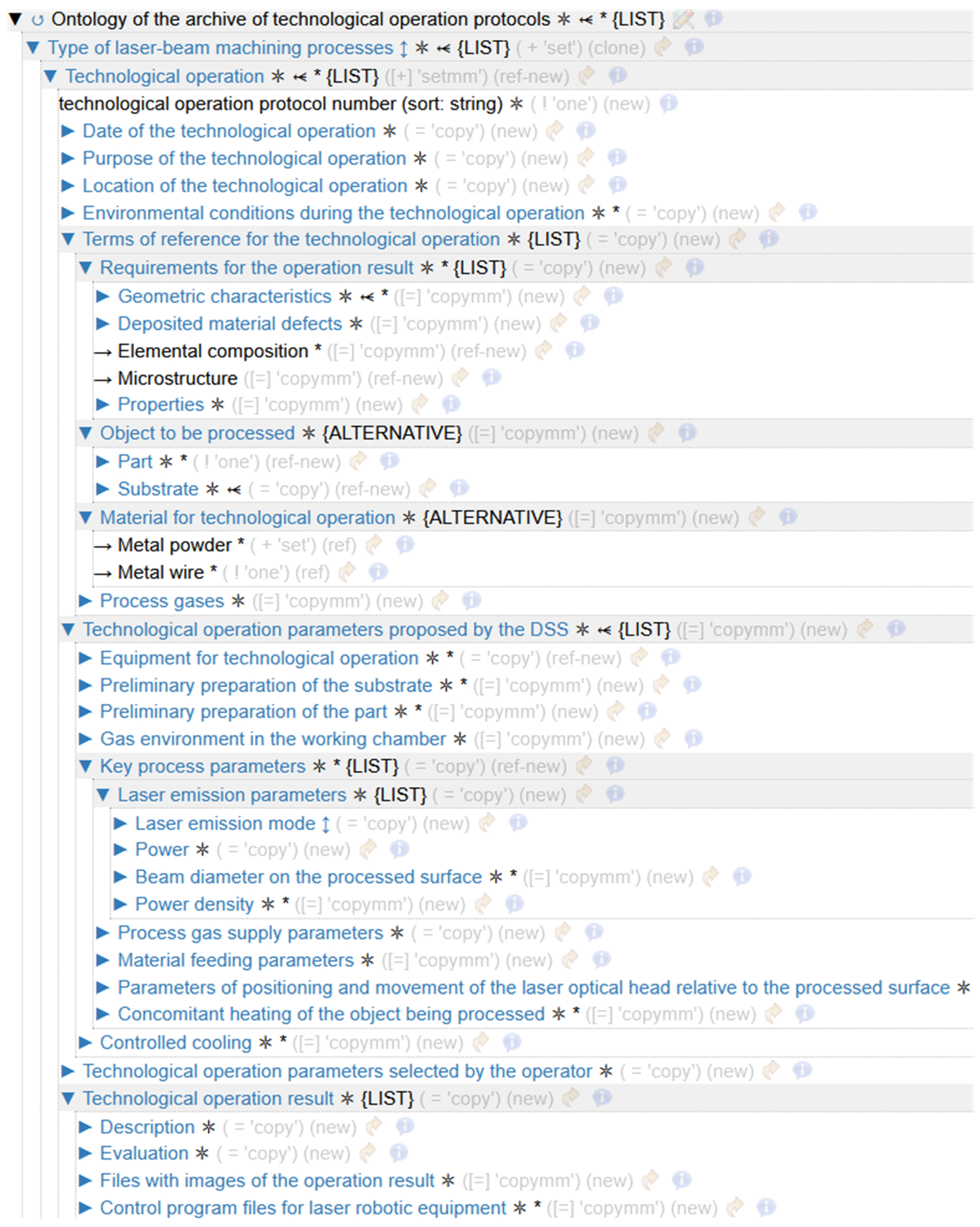
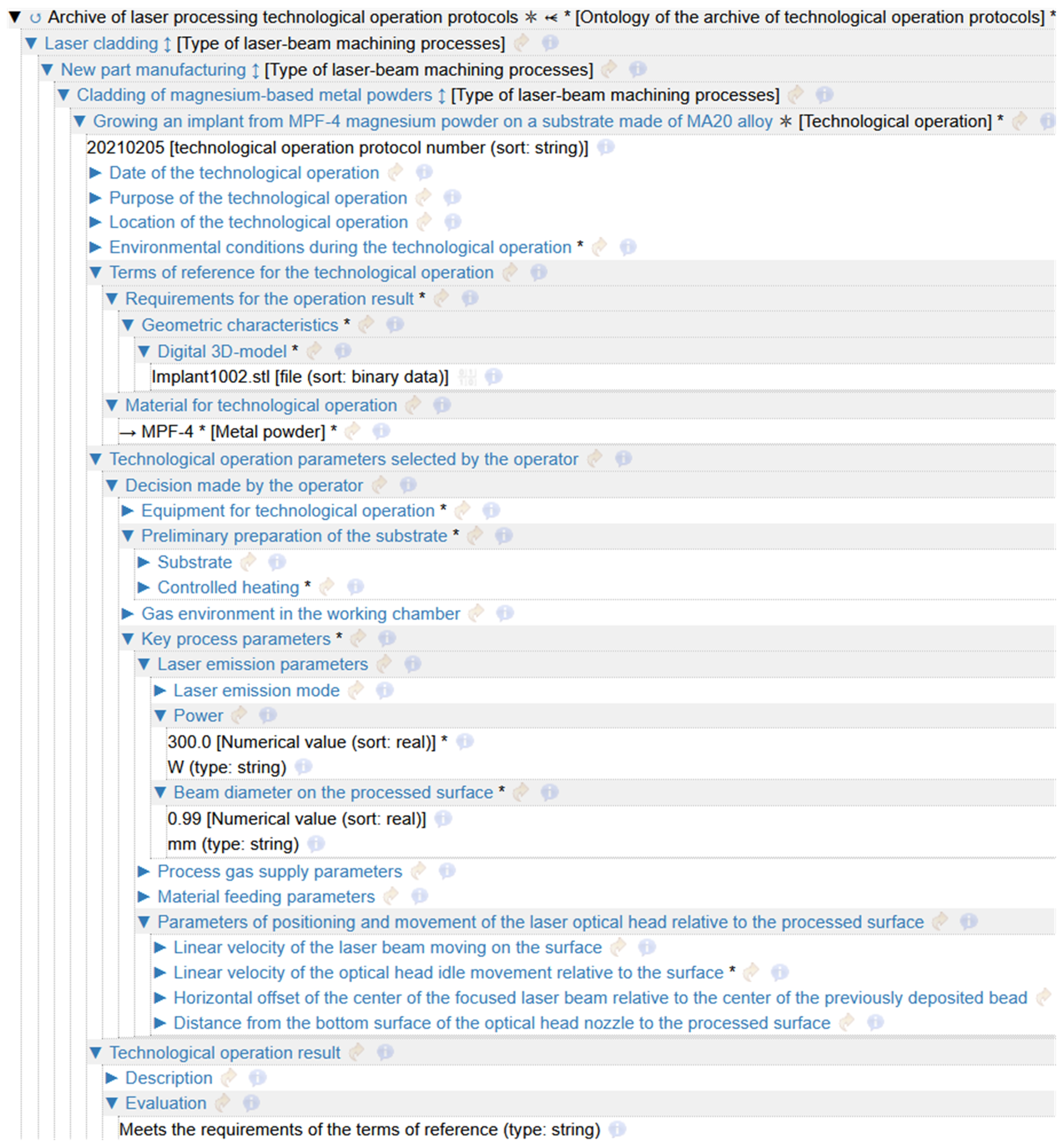
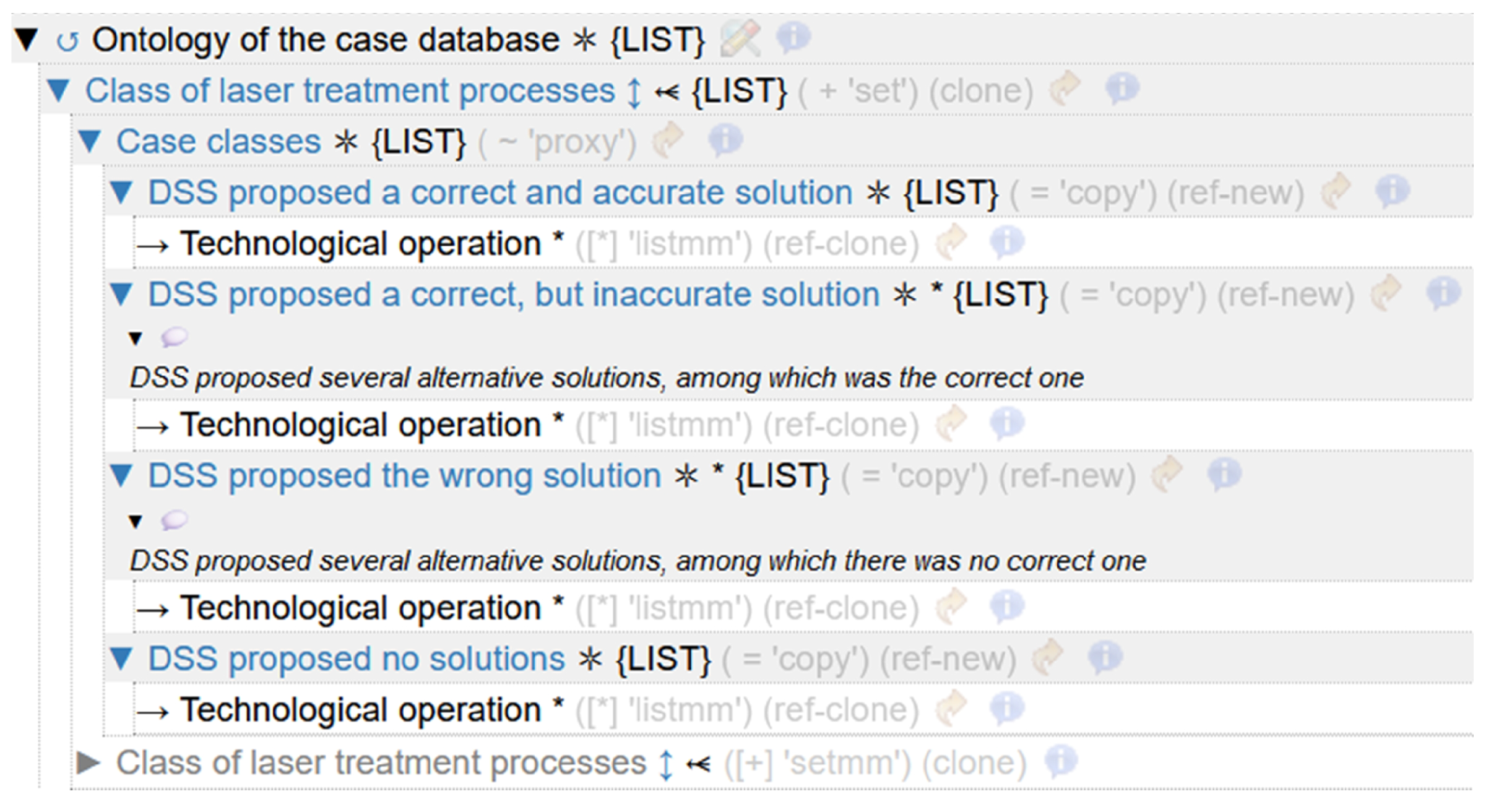
3.3. Ontology of the Knowledge Base
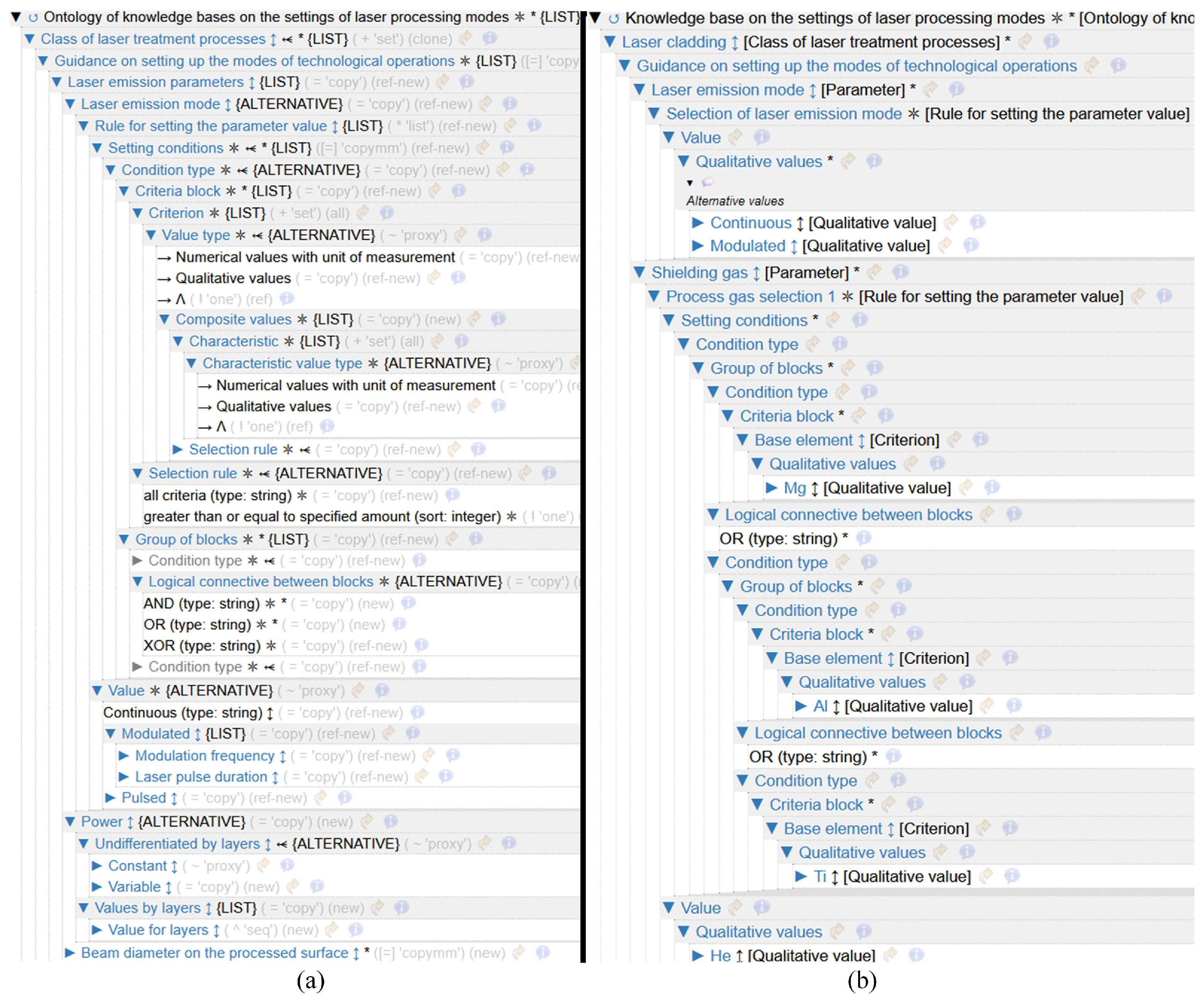
3.4. Implementation of the OM Ensemble
- The editing process is controlled by the underlying ontology model, and the user interface is generated basing on the ontology model;
- Any modifications to the ontology model trigger automatic adjustments to both the user interface and editing process (if required, all corresponding data and knowledge bases are also adjusted to ensure consistency with the modified ontology automatically).
4. Discussion and Future Work
- The possibilities of creating databases and knowledge bases using conceptual representation and terminology native to domain specialists;
- The scalability and operational extensibility of the DSS without the involvement of software developers. The emergence of new types of materials (alloys), lasers, and other technological equipment, the expansion of the range of processed parts, and the expansion/modification of knowledge bases should not (in most cases) require modifications to the ontology-oriented algorithms (being developed for interpreting subject databases) that perform reasoning based on concepts and relations specified in ontologies (which remain consistent under such changes).
5. Conclusions
Author Contributions
Funding
Institutional Review Board Statement
Informed Consent Statement
Data Availability Statement
Acknowledgments
Conflicts of Interest
References
- Joshi, S.; Martukanitz, R.P.; Nassar, A.R.; Michaleris, P. Additive Manufacturing with Metals: Design, Processes, Materials, Quality Assurance, and Applications; Springer: Cham, Switzerland, 2023. [Google Scholar] [CrossRef]
- Svetlizky, D.; Zheng, B.; Vyatskikh, A.; Das, M.; Bose, S.; Bandyopadhyay, A.; Schoenung, J.M.; Lavernia, E.J.; Eliaz, N. Laser-based directed energy deposition (DED-LB) of advanced materials. Mater. Sci. Eng. A 2022, 840, 142967. [Google Scholar]
- Zoting, S.; Shivarkar, A. Additive Manufacturing Market Size, Share, and Trends 2025 to 2034. 2025. Available online: https://www.precedenceresearch.com/additive-manufacturing-market (accessed on 18 February 2025).
- Ahn, D.G. Directed Energy Deposition (DED) Process: State of the Art. Int. J. Precis. Eng. Manuf.-Green Technol. 2021, 8, 703–742. [Google Scholar] [CrossRef]
- Piscopo, G.; Iuliano, L. Current research and industrial application of laser powder directed energy deposition. Int. J. Adv. Manuf. Technol. 2022, 119, 6893–6917. [Google Scholar] [CrossRef]
- Costello, S.C.; Cunningham, C.R.; Xu, F.; Shokrani, A.; Dhokia, V.; Newman, S.T. The state-of-the-art of wire arc directed energy deposition (WA-DED) as an additive manufacturing process for large metallic component manufacture. Int. J. Comput. Integr. Manuf. 2023, 36, 469–510. [Google Scholar] [CrossRef]
- Piscopo, G.; Atzeni, E.; Saboori, A.; Salmi, A. An Overview of the Process Mechanisms in the Laser Powder Directed Energy Deposition. Appl. Sci. 2023, 13, 117. [Google Scholar] [CrossRef]
- Arai, M.; Muramatsu, T.; Ito, K.; Izumi, T.; Yokota, H. Three-dimensional numerical simulation of repairing process by laser direct energy deposition. J. Therm. Spray Technol. 2023, 32, 111–123. [Google Scholar] [CrossRef]
- Ethiraj, N.; Sivabalan, T.; Sofia, J.; Harika, D.; Nikolova, M.P. A comprehensive review on application of machine intelligence in additive manufacturing. Turk. J. Eng. 2025, 9, 37–46. [Google Scholar] [CrossRef]
- Sibisi, T.H.; Shongwe, M.B.; Tshabalala, L.C.; Mathoho, I. LAM additive manufacturing: A fundamental review on mechanical properties, common defects, dominant processing variables, and its applications. Int. J. Adv. Manuf. Technol. 2023, 128, 2847–2861. [Google Scholar] [CrossRef]
- Fan, H.L.; Liu, Y.B.; Wang, Z.W.; Han, R.H.; Zheng, M.J.; Qi, H.B. Analysis of powder flow from the nozzle to the substrate in multiangle laser cladding. J. Laser Appl. 2024, 36, 042080. [Google Scholar] [CrossRef]
- Klahn, C.; Butler, D.; Pei, E. Economics of Additive Manufacturing. In Springer Handbook of Additive Manufacturing; Springer: Cham, Switzerland, 2023; pp. 31–42. [Google Scholar] [CrossRef]
- Soori, M.; Jough, F.K.G.; Dastres, R.; Arezoo, B. Additive Manufacturing Modification by Artificial Intelligence, Machine Learning, and Deep Learning: A Review. Addit. Manuf. Front. 2025, 200198. [Google Scholar] [CrossRef]
- Singh, C.; Sharma, N.; Kumar, N. Analysis Of Software Maintenance Cost Affecting Factors And Estimation Models. Int. J. Sci. Technol. Res. 2019, 8, 276–281. [Google Scholar]
- Islam, M.; Farooqui, N.; Haleem, M.; Zaidi, S. An Efficient Framework For Software Maintenance Cost Estimation Using Genetic Hybrid Algorithm: OOPs Prospective. Int. J. Comput. Digit. Syst. 2023, 14, 933–943. [Google Scholar] [CrossRef]
- Papakostas, N.; Newell, A.; George, A. An agent-based decision support platform for additive manufacturing applications. Appl. Sci. 2020, 10, 4953. [Google Scholar] [CrossRef]
- Inayathullah, S.; Buddala, R. Review of machine learning applications in additive manufacturing. Results Eng. 2025, 25, 103676. [Google Scholar] [CrossRef]
- Chen, K.; Zhang, P.; Yan, H.; Chen, G.; Sun, T.; Lu, Q.; Chen, Y.; Shi, H. A review of machine learning in additive manufacturing: Design and process. Int. J. Adv. Manuf. Technol. 2024, 135, 1051–1087. [Google Scholar] [CrossRef]
- Xiao, J.; Anwer, N.; Huang, H.; Bonnard, R.; Eynard, B.; Huang, C.; Pei, E. Information exchange and knowledge discovery for additive manufacturing digital thread: A comprehensive literature review. Int. J. Comput. Integr. Manuf. 2024, 1–26. [Google Scholar] [CrossRef]
- Beniwal, R.; Abhijeet, K.; Kumar, K.; Sagar, M. Ontology Driven Software Development for Better Understanding and Maintenance of Software System. In Proceedings of the Second International Conference on Sustainable Technologies for Computational Intelligence, Dehradun, India, 23–24 December 2022; Luhach, A.K., Poonia, R.C., Gao, X.Z., Singh Jat, D., Eds.; Springer: Singapore, 2022; pp. 73–81. [Google Scholar]
- Abu-Salih, B.; Al-Tawil, M.; Khoury, A.; Al-Qudah, D.A.; Abu Zaid, I.; Alabdale, M.; Azar, D. MAD-Onto: An ontology design for mobile app development. Front. Artif. Intell. 2025, 8, 1508225. [Google Scholar] [CrossRef]
- Chuprina, S.I.; Ryabinin, K.V.; Koznov, D.V.; Matkin, K.A. Ontology-driven visual analytics software development. Program. Comput. Softw. 2022, 48, 208–214. [Google Scholar] [CrossRef]
- Gribova, V.V.; Kleshchev, A.S.; Moskalenko, F.M.; Timchenko, V.A. A two-level model of information units with complex structure that correspond to the questioning metaphor. Autom. Doc. Math. Linguist. 2015, 49, 172–181. [Google Scholar] [CrossRef]
- Ataeva, O.M.; Serebryakov, V.A.; Tuchkova, N.P. Ontological approach to a knowledge graph construction in a semantic library. Lobachevskii J. Math. 2023, 44, 2229–2239. [Google Scholar] [CrossRef]
- Meyers, B.; Vangheluwe, H.; Lietaert, P.; Vanderhulst, G.; Van Noten, J.; Schaffers, M.; Maes, D.; Gadeyne, K. Towards a knowledge graph framework for ad hoc analysis in manufacturing. J. Intell. Manuf. 2024, 35, 3731–3752. [Google Scholar] [CrossRef]
- Afrasiabi, M.; Bambach, M. Modelling and simulation of metal additive manufacturing processes with particle methods: A review. Virtual Phys. Prototyp. 2023, 18, e2274494. [Google Scholar] [CrossRef]
- Gribova, V.; Kulchin, Y.; Nikitin, A.; Timchenko, V. The Concept of Support for Laser-Based Additive Manufacturing on the Basis of Artificial Intelligence Methods. Lect. Notes Comput. Sci. 2020, 12412, 403–415. [Google Scholar]
- Gribova, V.; Kulchin, Y.; Nikitin, A.; Velichko, A.; Basakin, A.; Timchenko, V. The Concept of Intelligent Support for Laser Additive Manufacturing Process Engineer. In Proceedings of the Studies in Systems, Decision and Control; Springer: Cham, Switzerland, 2023; Volume 457, pp. 355–368. [Google Scholar] [CrossRef]
- Gribova, V.V.; Moskalenko, P.M.; Timchenko, V.A.; Shalfeeva, E.A. The IACPaaS Platform for Developing Systems Based on Ontologies: A Decade of Use. Sci. Tech. Inf. Process. 2023, 50, 406–413. [Google Scholar] [CrossRef]
- Li, S.; Feng, S.; Kuan, A.; Lu, Y. Toward a standard data architecture for additive manufacturing. JOM 2024, 76, 1905–1912. [Google Scholar] [CrossRef]
- Huang, M.; Fan, B.; Chen, L.; Pan, Y.; Qin, Y. Selection of Additive Manufacturing Machines via Ontology-Supported Multi-Attribute Three-Way Decisions. Appl. Sci. 2023, 13, 2926. [Google Scholar] [CrossRef]
- Phillips, P.J.; Hahn, C.A.; Fontana, P.C.; Yates, A.N.; Greene, K.; Broniatowski, D.A.; Przybocki, M.A. Four Principles of Explainable Artificial Intelligence. 2021. Available online: https://nvlpubs.nist.gov/nistpubs/ir/2021/NIST.IR.8312.pdf (accessed on 6 February 2025).

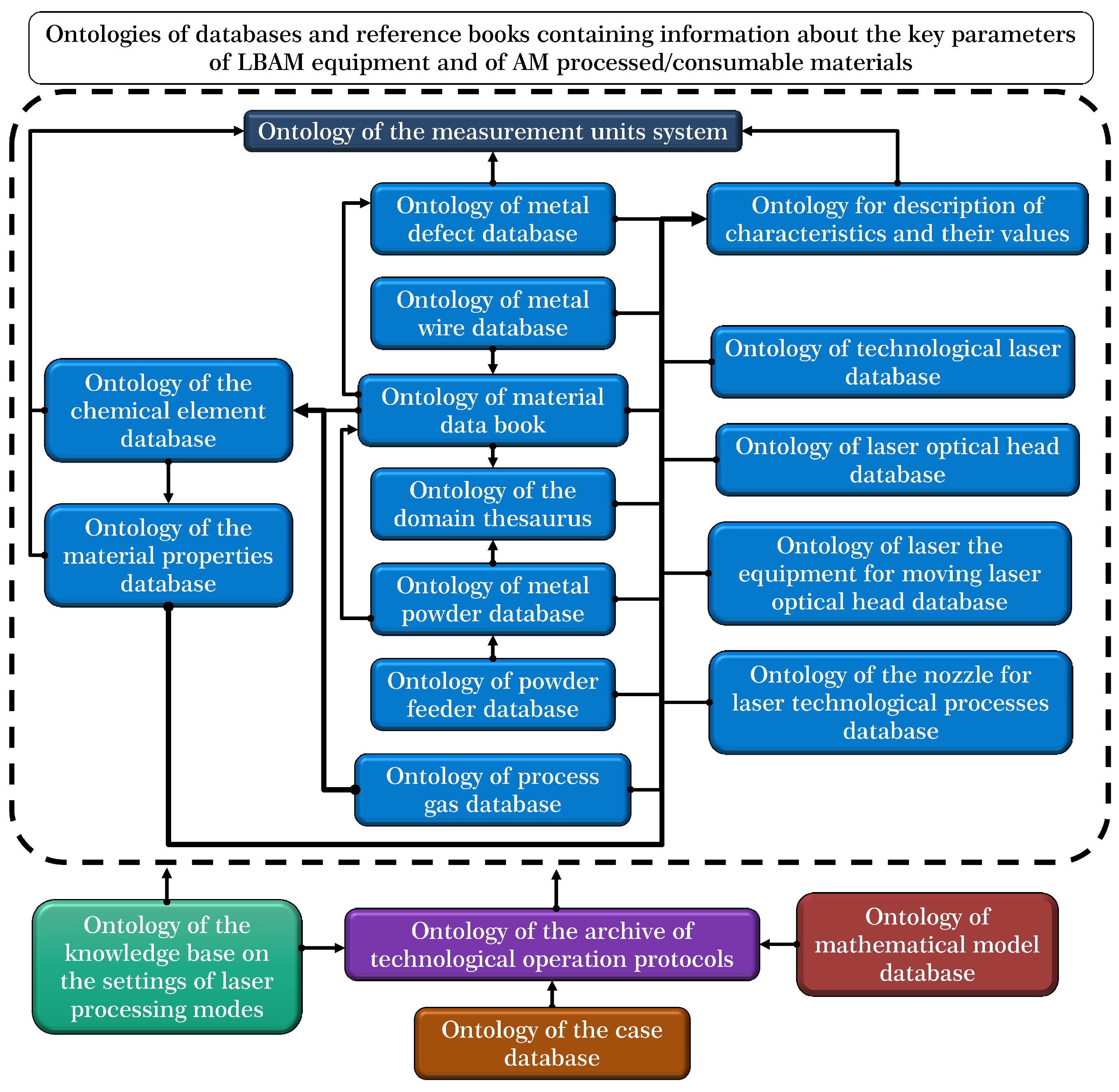
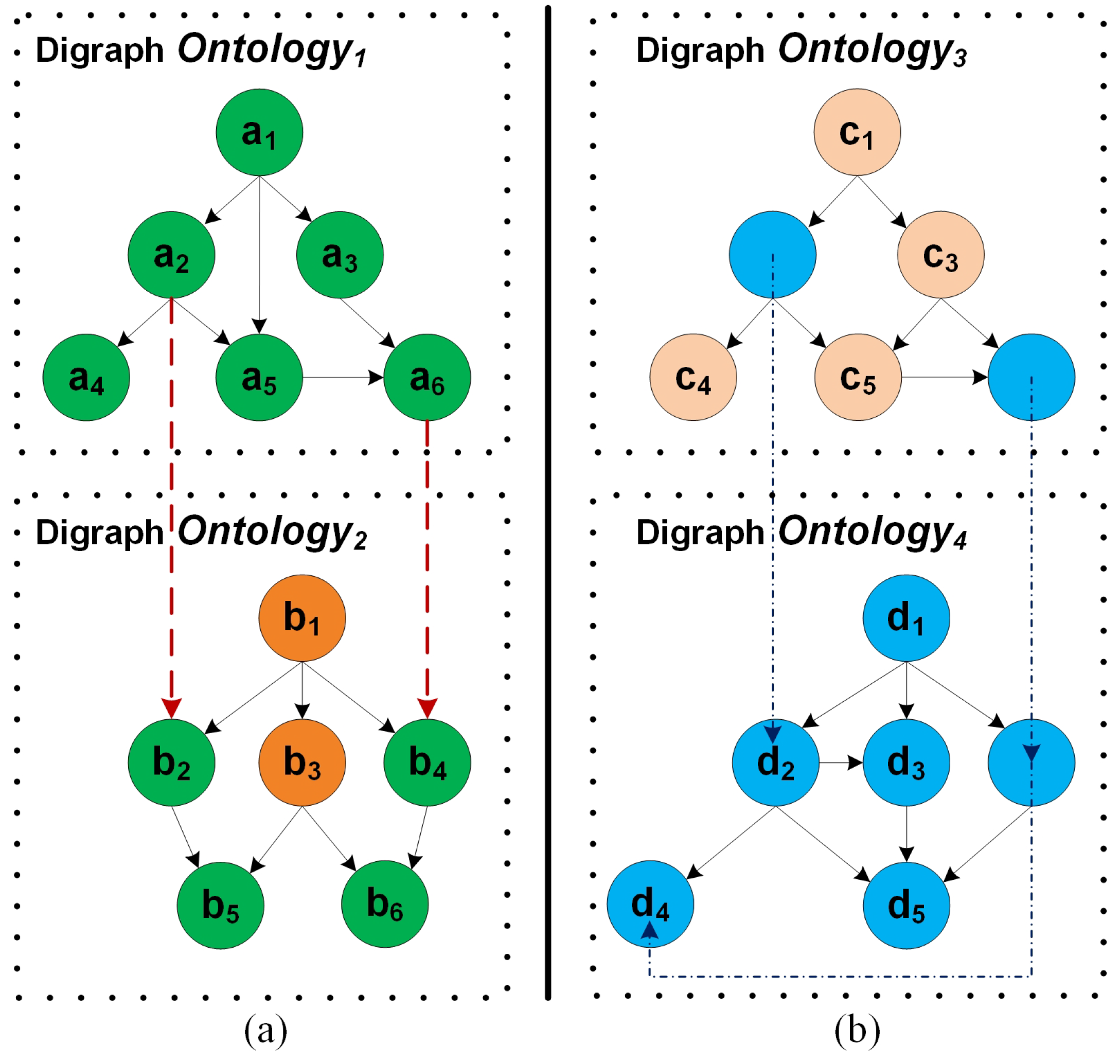
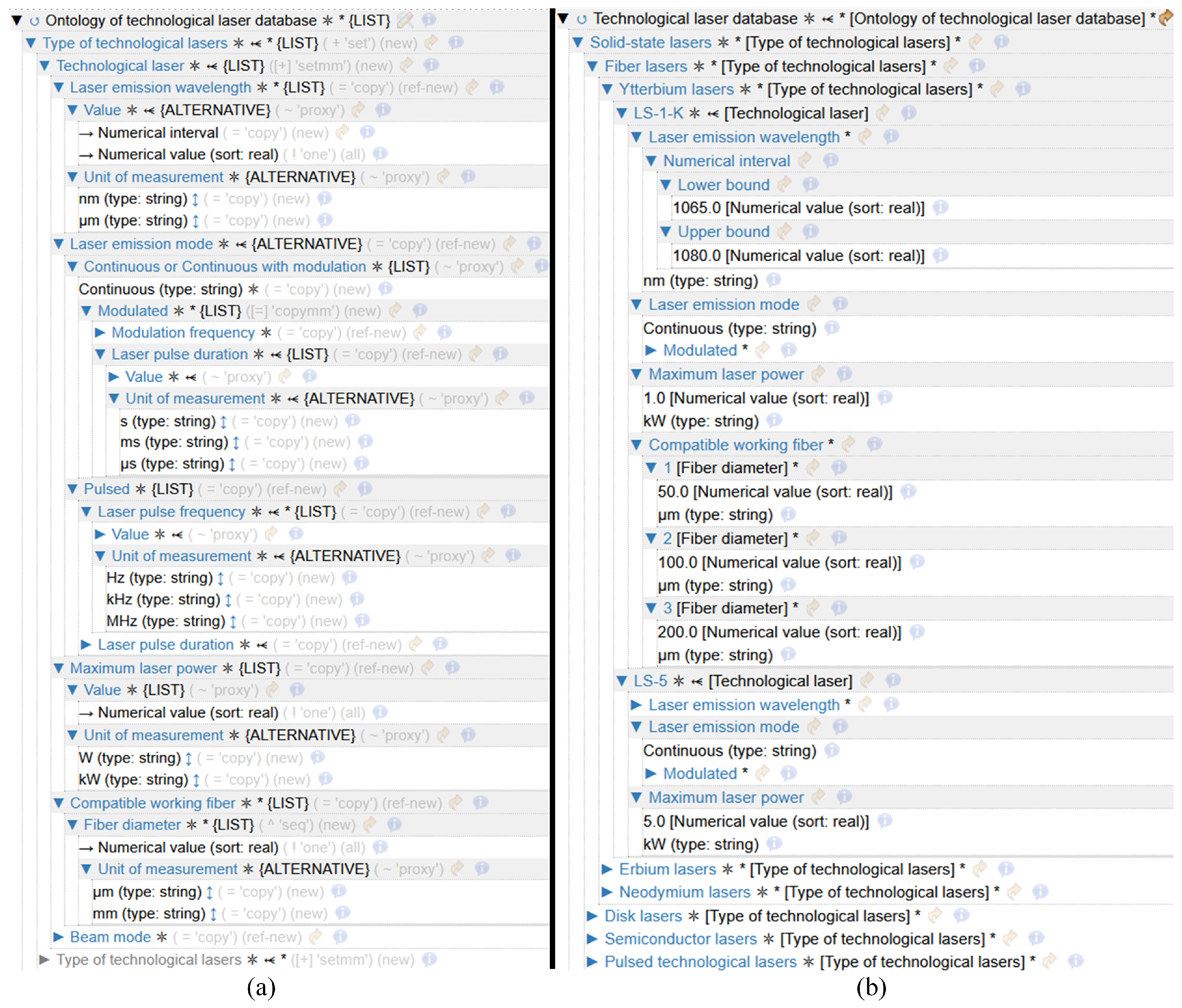
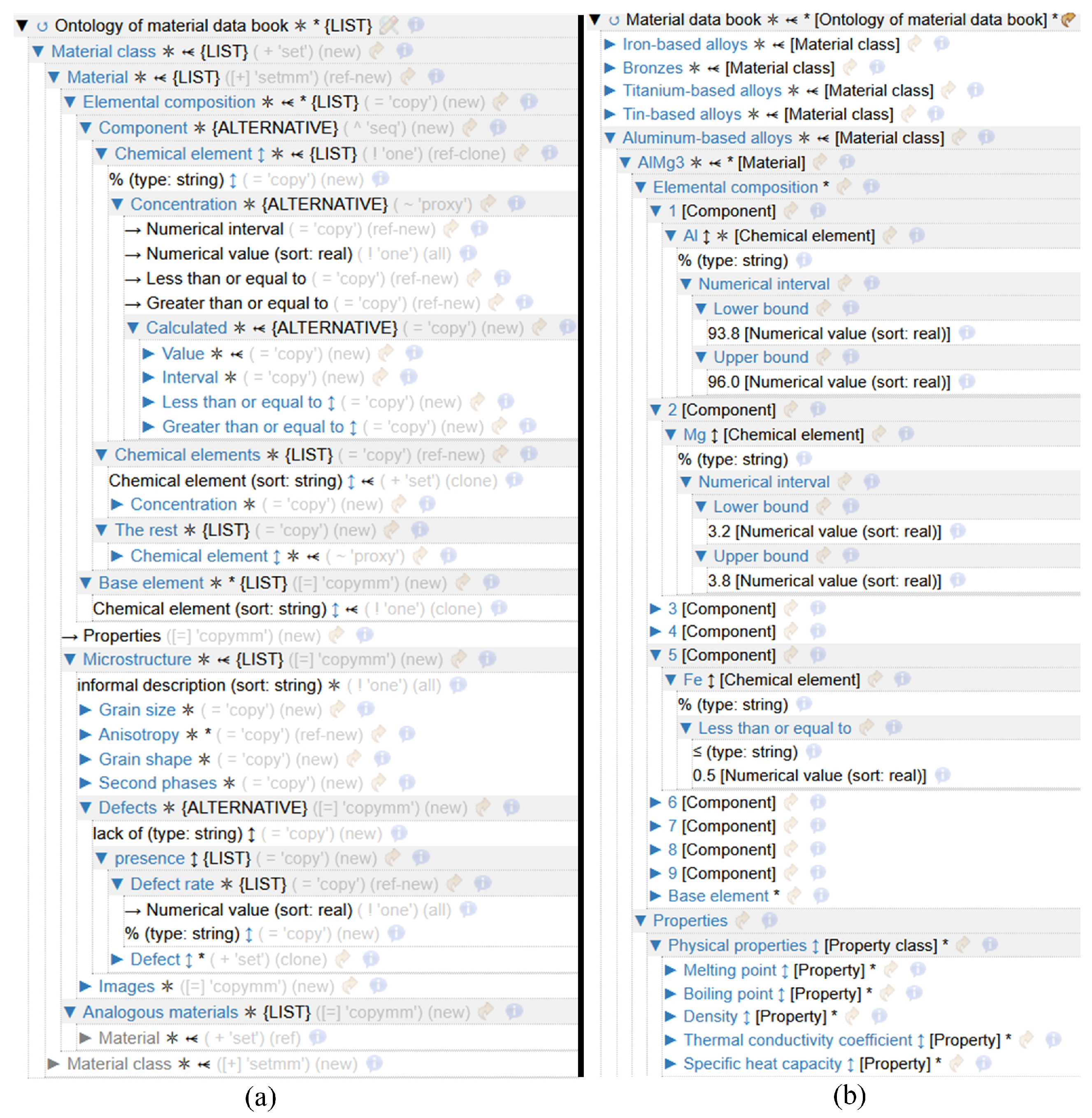
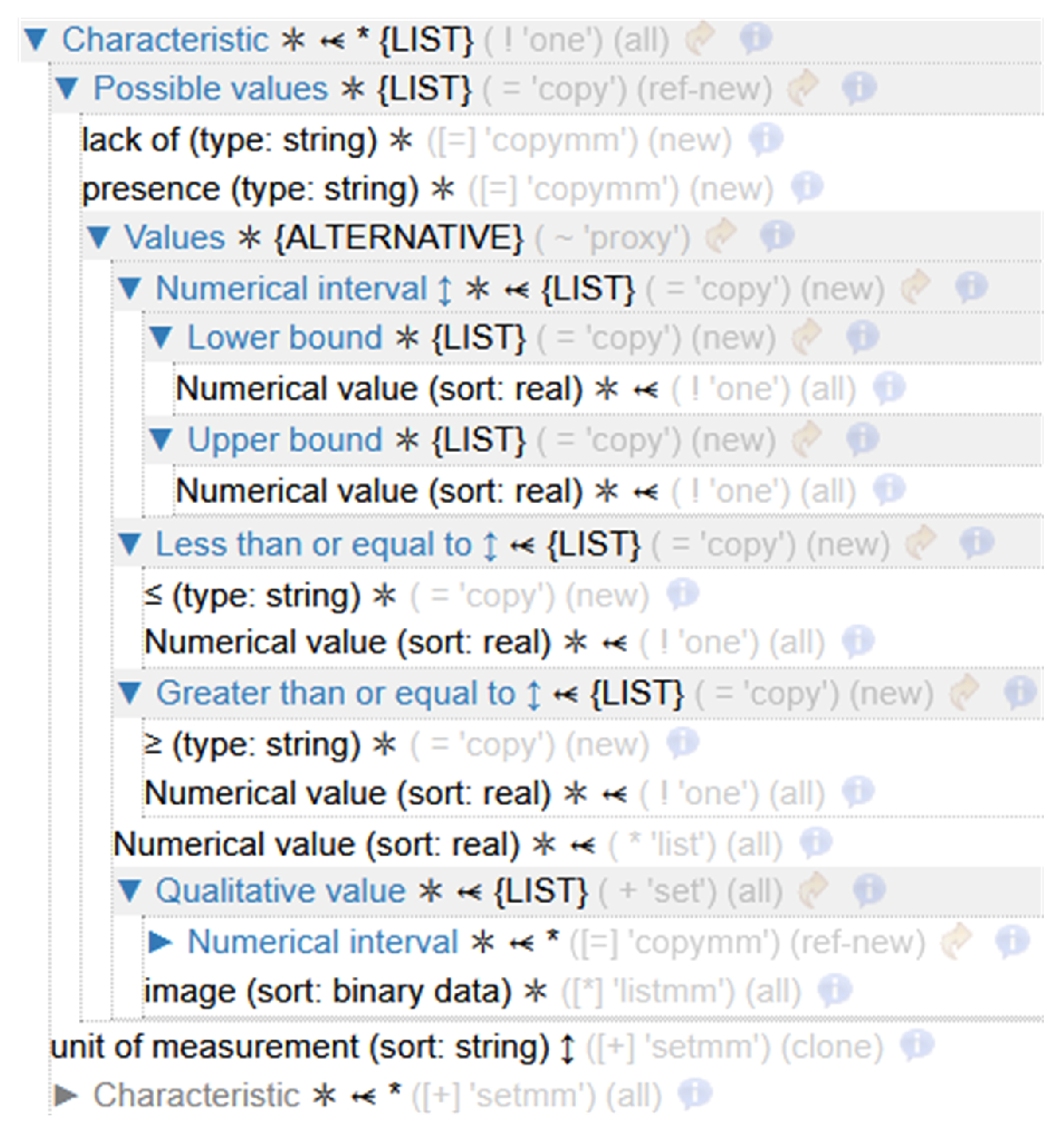
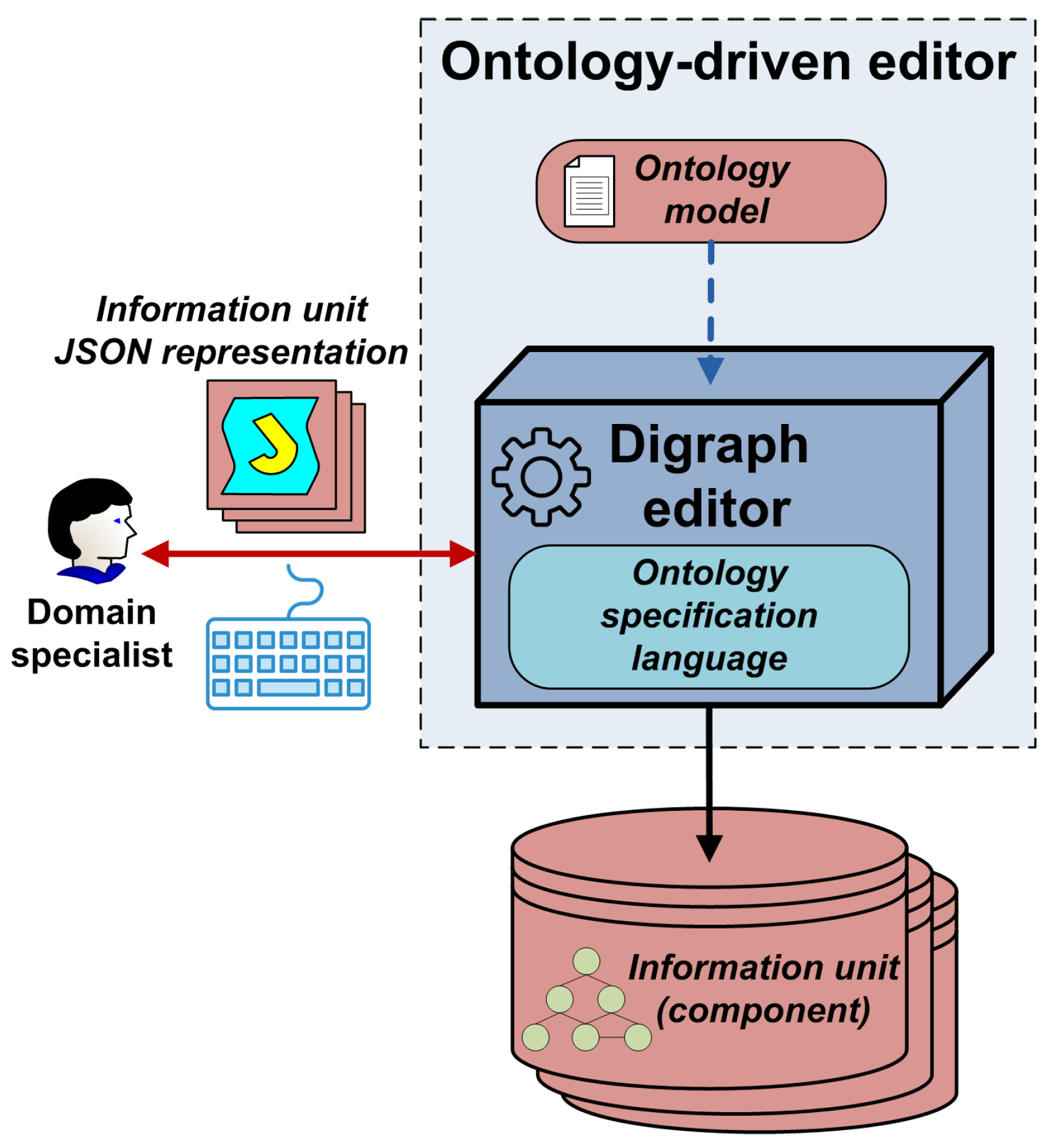
Disclaimer/Publisher’s Note: The statements, opinions and data contained in all publications are solely those of the individual author(s) and contributor(s) and not of MDPI and/or the editor(s). MDPI and/or the editor(s) disclaim responsibility for any injury to people or property resulting from any ideas, methods, instructions or products referred to in the content. |
© 2025 by the authors. Licensee MDPI, Basel, Switzerland. This article is an open access article distributed under the terms and conditions of the Creative Commons Attribution (CC BY) license (https://creativecommons.org/licenses/by/4.0/).
Share and Cite
Gribova, V.; Kulchin, Y.; Nikitin, A.; Nikiforov, P.; Basakin, A.; Kudriashova, E.; Timchenko, V.; Zhevtun, I. A Multi-Model Ontological System for Intelligent Assistance in Laser Additive Processes. Appl. Sci. 2025, 15, 4396. https://doi.org/10.3390/app15084396
Gribova V, Kulchin Y, Nikitin A, Nikiforov P, Basakin A, Kudriashova E, Timchenko V, Zhevtun I. A Multi-Model Ontological System for Intelligent Assistance in Laser Additive Processes. Applied Sciences. 2025; 15(8):4396. https://doi.org/10.3390/app15084396
Chicago/Turabian StyleGribova, Valeriya, Yury Kulchin, Alexander Nikitin, Pavel Nikiforov, Artem Basakin, Ekaterina Kudriashova, Vadim Timchenko, and Ivan Zhevtun. 2025. "A Multi-Model Ontological System for Intelligent Assistance in Laser Additive Processes" Applied Sciences 15, no. 8: 4396. https://doi.org/10.3390/app15084396
APA StyleGribova, V., Kulchin, Y., Nikitin, A., Nikiforov, P., Basakin, A., Kudriashova, E., Timchenko, V., & Zhevtun, I. (2025). A Multi-Model Ontological System for Intelligent Assistance in Laser Additive Processes. Applied Sciences, 15(8), 4396. https://doi.org/10.3390/app15084396





